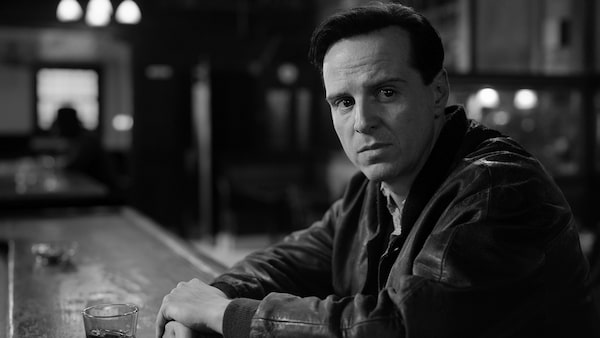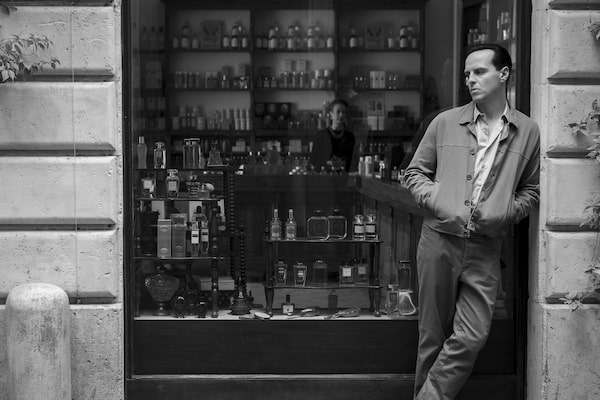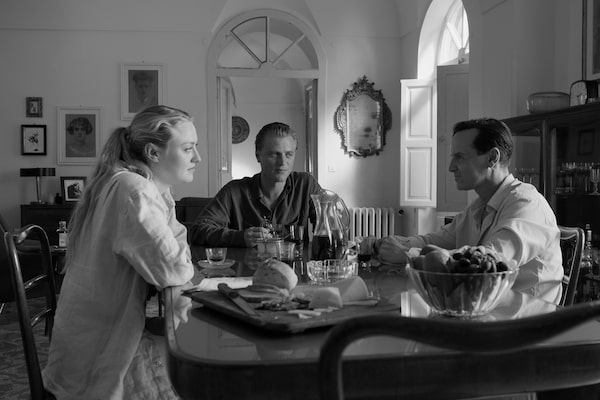
Andrew Scott as Tom Ripley in a scene from Ripley.Courtesy of Netflix/The Associated Press
The prestige-television psychopath has returned in Netflix’s Ripley – and makes for as riveting entertainment as ever.
American novelist Patricia Highsmith’s Tom Ripley is played to perfection by Andrew Scott in this latest of the great grifter’s many onscreen incarnations.
The character’s queerness in both senses – his repressed something-sexuality, and his unnervingly placid personality – is at the centre of Scott’s understated, unsettling depiction. The actor’s sheepishly hungry, toothy smile – one deployed to set hearts a flutter or break them in shows and films from Fleabag to All Of Us Strangers – here twists into a comic, cruel grin.
In his ethereal, frequently silent performance, Scott demonstrates again why he’s become the holy spirit of the current trinity of top-shelf Irish thespians. (Cillian Murphy is the father, I guess, and Paul Mescal the son.)
While Highsmith’s novels about Tom Ripley have made it to the big screen with regularity since they were published starting in 1955 – notably in 1999′s The Talented Mr. Ripley with Matt Damon, Jude Law and Gwyneth Paltrow – the popular intellectual property has somehow eluded a proper small-screen adaption until now.
Indeed, Ripley arrives just as the medium’s obsession with anti-heroes who sit on a spectrum from sociopath to psychopath, from The Sopranos to Dexter, seemed to have finally petered out.

Tom Ripley, played by Andrew Scott, easily implicates himself in the life of the poor little lost rich boy Dickie.Stefano Cristiano Montesi/The Associated Press
The first season – please let this exquisite eight episodes based on The Talented Mr. Ripley be only the first, Netflix; there are four more books – is written and directed by industry veteran Steven Zaillian. The Oscar-winning screenwriter of Schindler’s List previously gripped television viewers with the HBO thriller The Night Of, but his eclectic excellence also includes Awakenings (1990) and The Irishman (2019).
He hasn’t changed the plot other than moving it forward a few years to the early 1960s.
Struggling along running low-stakes scams in New York, Ripley is summoned one day by a shipping magnate named Herbert Greenleaf, played by playwright/filmmaker Kenneth Lonergan. (This is the first of many enjoyably off-centre casting choices, along with memorable cameos by John Malkovich, a past Ripley himself, and Sting offspring Eliot Sumner). Greenleaf wants to send him overseas to persuade his son, Dickie, to return to the United States.
Arriving on the Amalfi Coast, Ripley easily implicates himself in the life of the poor little lost rich boy Dickie (a melancholy Johnny Flynn), much to the barely disguised disgust of his girlfriend, Marge (a deliciously deadpan Dakota Fanning), and quickly falls for the size of his trust fund.
While Ripley is very much an adaptation for the streaming era – though I recommend resisting the urge to binge and savouring it instead – there’s a nostalgia for an older era of thrillers in Zaillian’s approach. He shoots in black and white, has a Hitchcockian obsession with stairs and staircases and moves things forward at a slow, stately pace that allows the viewer to pay close attention to the particularities of a bygone age.
The devil is, after all, not in Ripley’s impulsive violence, but the details before and after: the unscrewing of a fountain pen ahead of the forging of a signature, the steaming open of an envelope, the distinct positioning of letters on an individual’s private typewriter.
Ripley’s visits to American Express offices to pick up packages or encounters with hotel desk clerk after hotel desk clerk are made truly fascinating in a way that is true to Highsmith’s writing.
In almost every other shot, Zaillian focuses for a moment on a piece of Italian art, and it’s a theme of this series that Tom Ripley is as much an aspiring artist learning his craft and making mistakes along the way as the expat wannabe painter Dickie.

Dakota Fanning, who plays Marge, along with Johnny Flynn, who portrays Dickie, and Andrew Scott, who plays the titular character in a scene from Ripley.Courtesy of Netflix/The Associated Press
Dickie thinks he’s imparting a lesson in art history when he takes Ripley on a tour of the Caravaggios in nearby towns, but it’s the story he tells of how that Italian renaissance painter killed a man and then fled to Venice that most interests – and perhaps inspires.
Ripley later shows a particular affinity for a Caravaggio canvas of David with the head of Goliath, in which the painter put his face on both David and the severed head of the giant. The bond, the unspoken attraction, between killer and victim is the mystery at the heart of the show.
When the inevitable murders do come, Zaillian finds a way to show them that are nauseating in the banality of their execution – and then follows them with set pieces for the cover-ups that are darkly comic and creative as anything out of the Coen brothers.
On top of all the superb, simmering storytelling, Ripley also has the Italian settings and actors to admire, with Maurizio Lombardi’s laconic inspector a standout. Expect booking.com and Expedia to both go down over the weekend as viewers suddenly develop the irresistible urge to make holiday plans.
 J. Kelly Nestruck
J. Kelly Nestruck